- Heart & Soil Newsletter
- Posts
- Growing Fruit & Nut Trees Organically in Cape Town
Growing Fruit & Nut Trees Organically in Cape Town
Most fruit can grow here; you just need to match conditions to suit the tree you are growing.
Hi! I'm Jo, writing from Heart & Soil homestead, a 1-acre homestead in the Far South of Cape Town, South Africa. Every week I share inspiration and education for your growing journey. Thanks so much for reading!
Today is about growing fruit and nuts organically in our Mediterranean climate. I have been growing trees for about fourteen years. Some knowledge I’ve learned from my dad, because permaculture didn’t always give me the tools I needed to serve trees’ needs better. In his generation, spraying was normal, so he’s had to adapt to a no-spray way of doing things. In his generation, it was also normal to have proper yields and make use of back garden fruit, so he also has had a lot of expertise to share with us. Integrating these two sets of knowledge has been key to our success.
The goal of this post is to help Cape Town residents grow volumes of organic fruit- imagine if every household had the skills and resources to grow, harvest, and process fruit for the family!
Your fruit tree/shrub knowledge will come from many places, and that’s how you’ll be able troubleshoot challenges and keep growing.
This is a post that I’ll update on the web version from time to time, so that it keeps expanding as a resource.
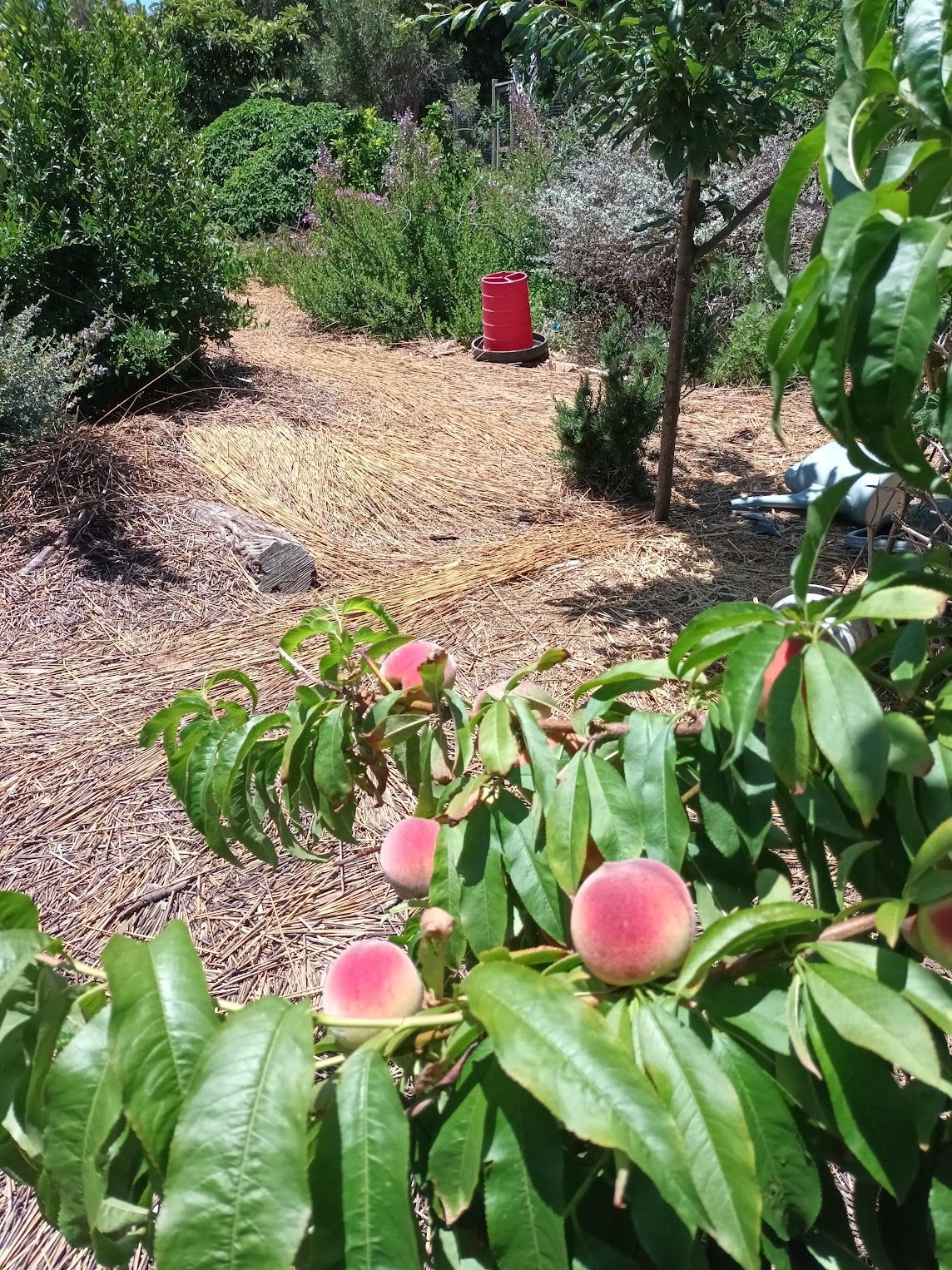
Peaches! Choosing a variety that fruits early in the summer will reduce the chances your organic peaches will be stung.
You can grow so many varieties of fruit and nuts in Cape Town. Our climate gives us extraordinary possibility. You do this by slowly observing your micro-climates. Micro-climates are small areas of your growing space that are warmer or colder, wetter or drier, windy or protected, shady or sunny. Once you understand micro-climates, you can map them to tree needs. This is a slow process, and you shouldn’t be hard on yourself if trees die in your first attempts.
We have hundreds of fruit and nut trees, bushes, and plants, and I love growing them. Figuring out what fruit you like to grow, fruit you have the correct conditions to grow, and fruit you have capacity to actually eat, takes time and effort.
With the exception of fruits that need a lot of cold to fruit (cherries, some blueberries, some apples/pears) there are an extraordinary variety of fruits to explore and experiment with in our climate.
I’ve started with some ideas for trees that yield quickly. My list perhaps include trees that you haven’t considered before. Yes, you can grow a food forest!
This is meant as a resource to come back to later when you are figuring out which fruit tree to plant next.
Elderberries
Elderberries are probably the easiest fruit to grow in Cape Town. The two main caveats: You need to be sure the variety is fruiting (so you can’t just get an invasive one from the side of the road- usually the invasive variety doesn’t fruit well). Advantages: makes an incredible windbreak and habitat for birds, flowers are edible and fragrant, fruit is highly medicinal. Disadvantages: can be invasive (ours are specifically selected not to send out a lot of runners). Time-consuming to pick the berries, and they have to be processed rather than just eaten.
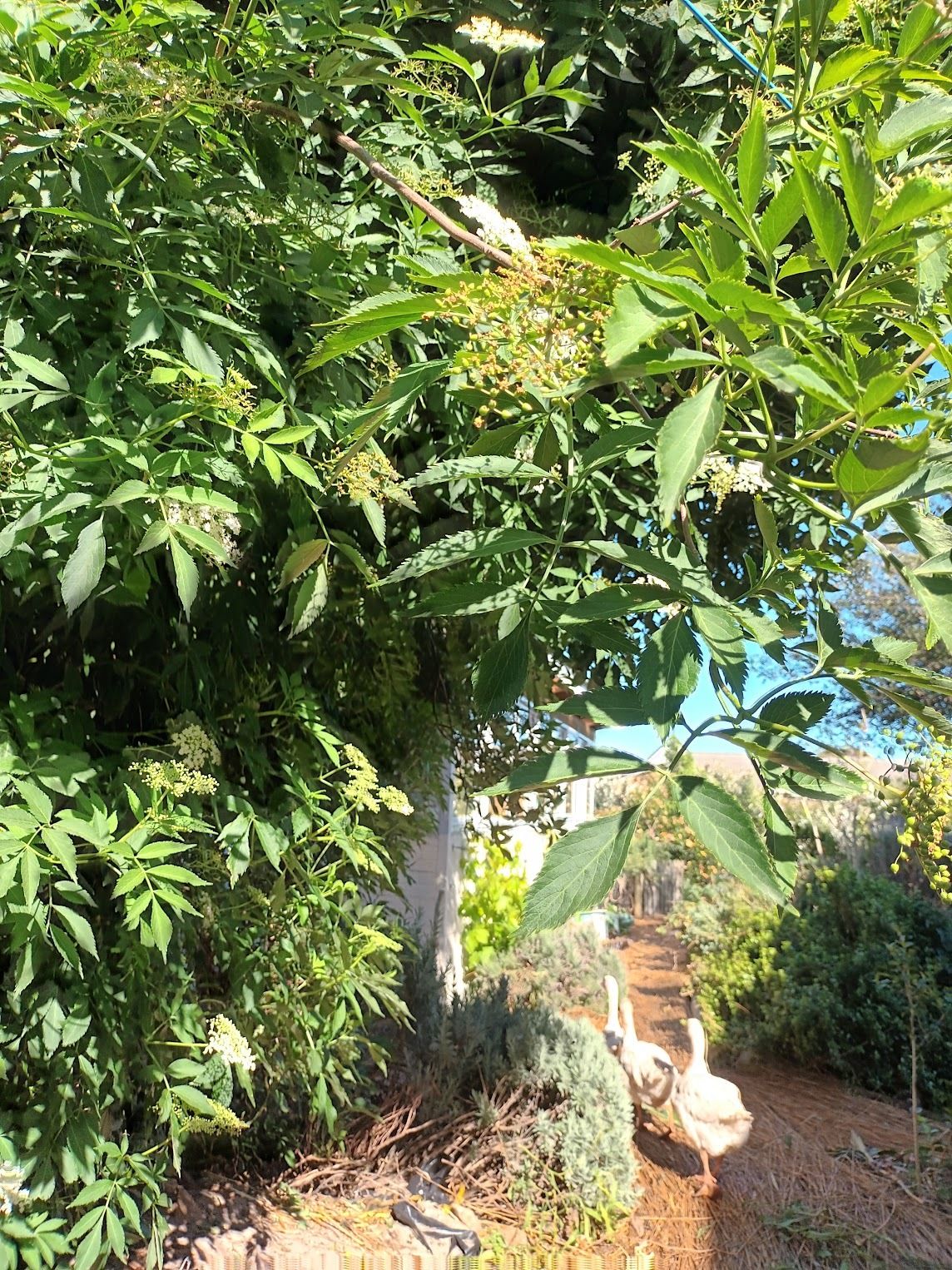
Elderberry this week. Lemon and Elderberry sorbet is super tasty. Elderberry syrup is a very tasty way to get through winter colds.
Tamarillo & Pawpaw
Not always easy to source, I group tamarillos and pawpaws (papaya) together because they both seem to like microbially dominated soil. They grow well in pots or vegetable beds. They can handle some wind, and can be really prolific once you get them going. You can grow them from seed, so you don’t need stacks of money to start. I love them because they add volumes of fruit to your garden using very little space. With a fleshy, rather than woody stem, they are not long-lived, so you have to plan to replace them both every few years.
You need to establish all short-lived trees and vines in the spring and early summer, so that they have a long growing season before the weather gets cooler. If they’re still small when the weather cools, they’re more likely to die in the winter.
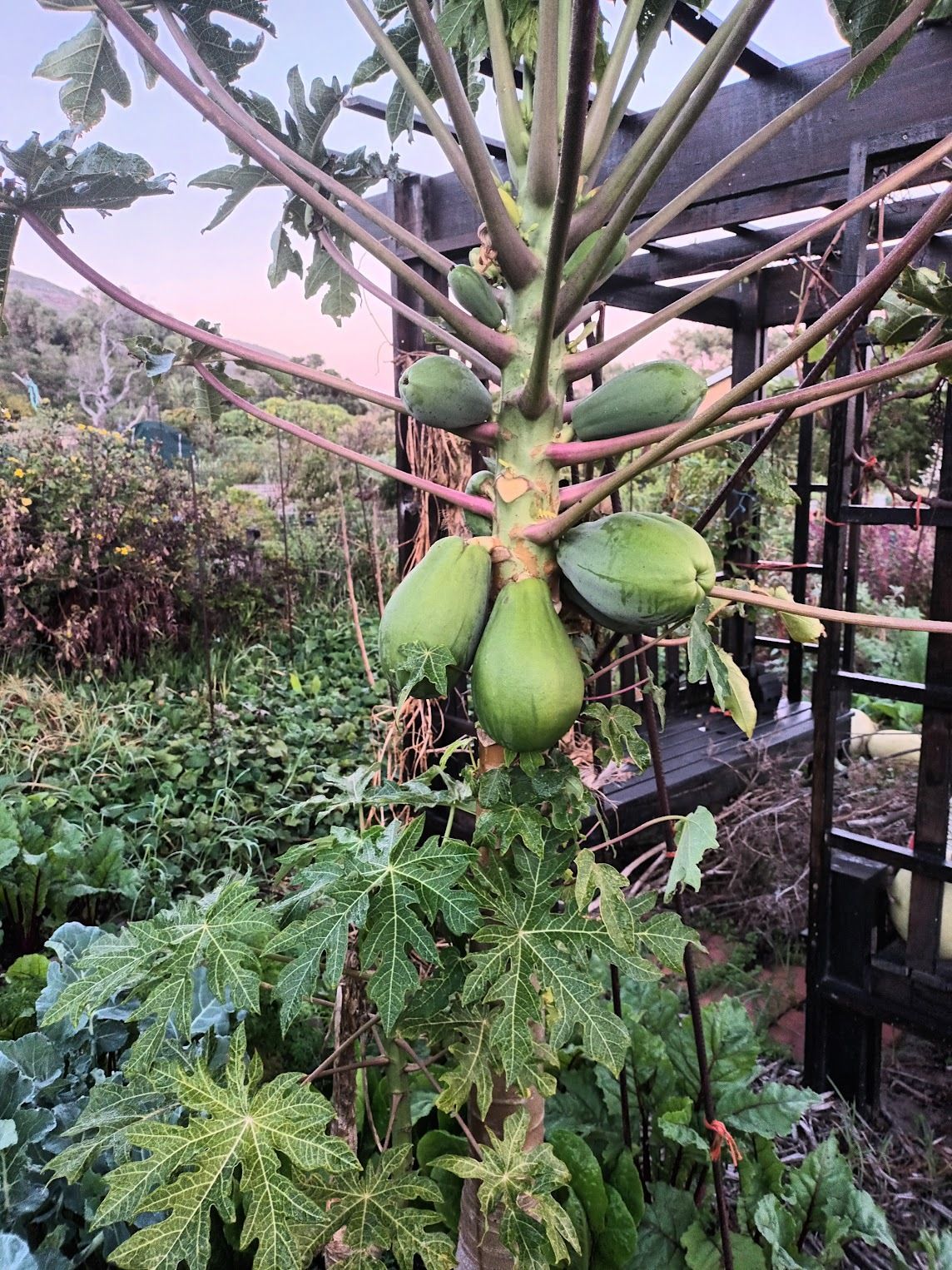
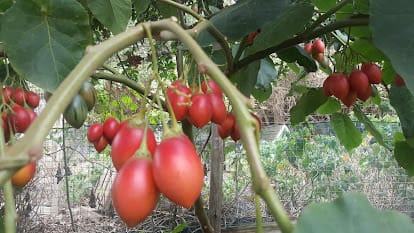
So much fruit on this tamarillo
Cape Gooseberries, Strawberries, Raspberries, Blackberries, Blueberries
Gooseberries are very easy to grow- you can just crush fruit and throw them down now and then, and after a while you’ll get gooseberry seedlings. Also very affordable to buy plants.
Strawberries need a good amount of water to do well. For me, starting with a whole bed of strawberries helped. When we just had one or two, it was difficult to see the value in them, and that led to neglect, which became a vicious cycle. If you start with at least six, you can start to get lots of runners, and then you’ll get meaningful numbers of strawberries. They can deal with full sun but then you need even more water, so partial shade can be helpful.
Blackberries grow well in Cape Town! They also like some water, and to be trained vertically. Blackberries don’t do well in our food forest, even though they are a classic understory plant. They do better in our shadiest veggie beds, where their roots are protected and they’re surface watered frequently. I have many thorny blackberries, and one thornless. I like the taste and growing habit of the thornless better, though both are great.
Raspberries are more finicky than blackberries, but again growing them in our vegetable beds has allowed us to make progress.
Blueberries are the most difficult berry to keep alive, given that they love acid soil and it’s quite hard to regulate acidity in the ground. Growing them in pots tends to have better results, and getting the largest plants you can afford is worth the extra expense. Look for blueberry varieties that are low-chill, which means that they don’t need a cold winter to fruit.
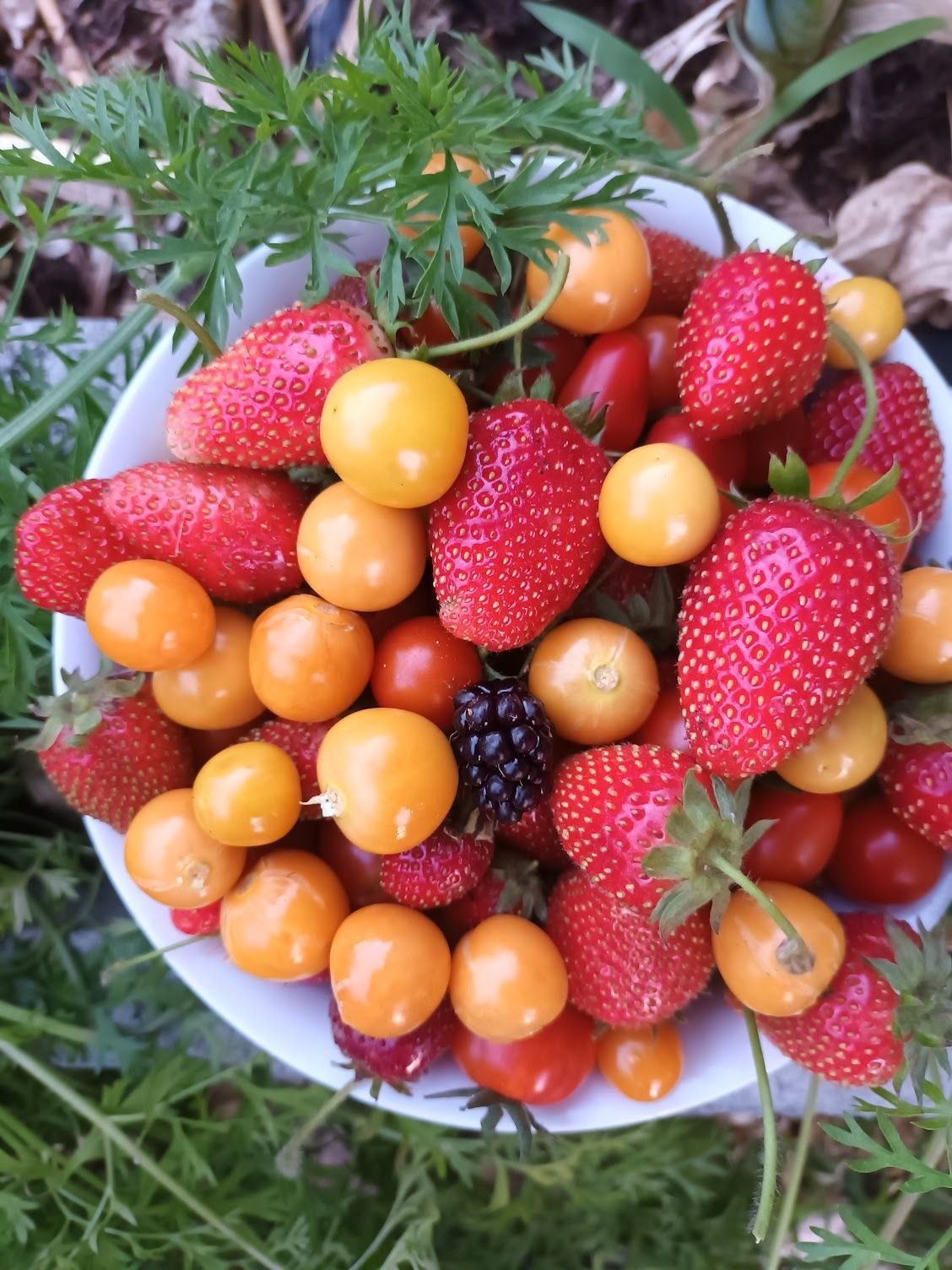
Nothing makes me feel richer than berries.
Granadillas
Granadillas are my favourite, most prolific fruit in Cape Town…. And I killed about 40 when we were getting going. In our microclimate, granadillas need friendship (pelargoniums, trees, bushes) to distract weevils or snails when they’re young. They need heavy feeding and a lot of water (but not standing water).
You have to just keep trying, until you succeed. They generally won’t do well climbing a super hot wall, or in full wind. But if you give them enough water, they may just push through.
They need to be planted out in spring and early summer, so that they grow relatively large before the winter. If they are small (less than 70cm or so), they will usually succumb to snails and cold in the winter. This is my #1 granadilla tip- plant in Oct-Dec, and baby them by watering and composting well for the first six months. This will stimulate lots and lots of growth, and sizwill help them survive the winter.
They don’t fruit well in pots, unless their roots can go through the bottom of the pot into the ground. Then they will typically have one incredible year, which usually takes about 2-3 years to arrive. So you need to have one waiting in the wings, because after the incredible year, decline and death arrives…
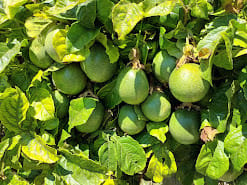
Guavas
Guavas grow incredibly quickly in Cape Town. Whereas in more subtropical areas of South Africa guavas are often stung, we are mostly very lucky and have hundreds, if not thousands, of fruits each year. Birds tend to peck the fruit in high branches, which can lead to problems if there’s a lot of fallen blemished fruit. Chickens can help break the fruit fly cycle created by fallen fruit. Otherwise consistently adding compost and mulch can create an environment where good fungi and bacteria outcompete the fruit fly.
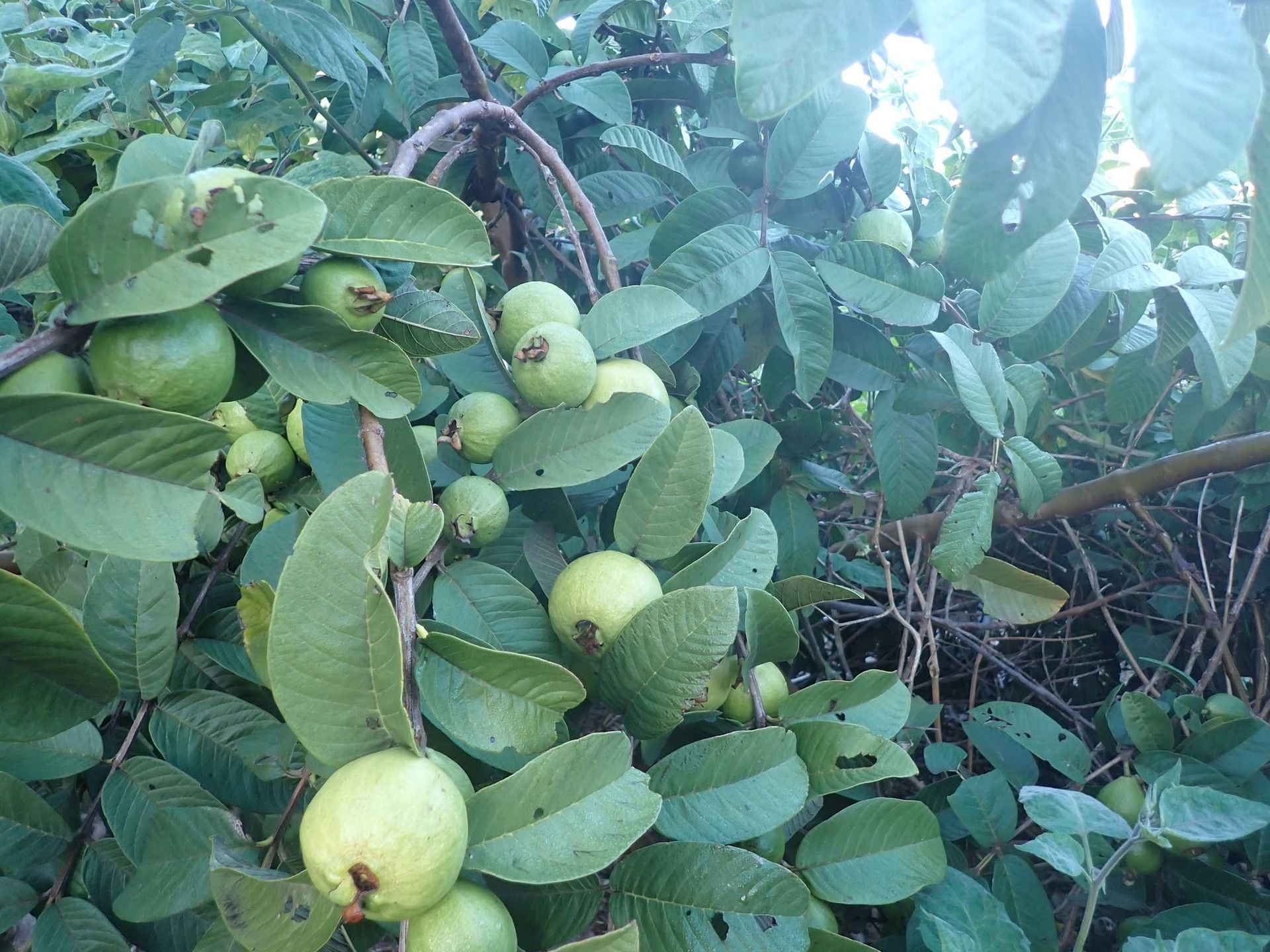
Loquats
Loquats are very easy to grow in Cape Town, and they make beautiful trees. They are NOT rated as invasive IF they are being grown in Cape Town for fruit for human consumption. Like guavas, they can attract fruit flies when overripe, so the chickens and regular compost helps. Loquats can also survive in high wind and low water conditions, so they’re a good choice for a harsh corner of your space, or for when you’re not confident in your growing abilities. They can also deal with full sun.
Olives
Olives are another beautiful and easy tree in our windy climate- and they actually love wind! Olives are wind-pollinated, so it’s a good idea to have a couple of trees, ideally of different cultivars. They do need to be pruned to get a good harvest, and they also tend to have a good fruiting year followed by a less good year. They can handle low-water conditions.
Mulberries
Mulberries are easy, awesome and beautiful, and only certain varieties are rated as invasive. The mulberries you’ll see sold in nurseries are not invasive.
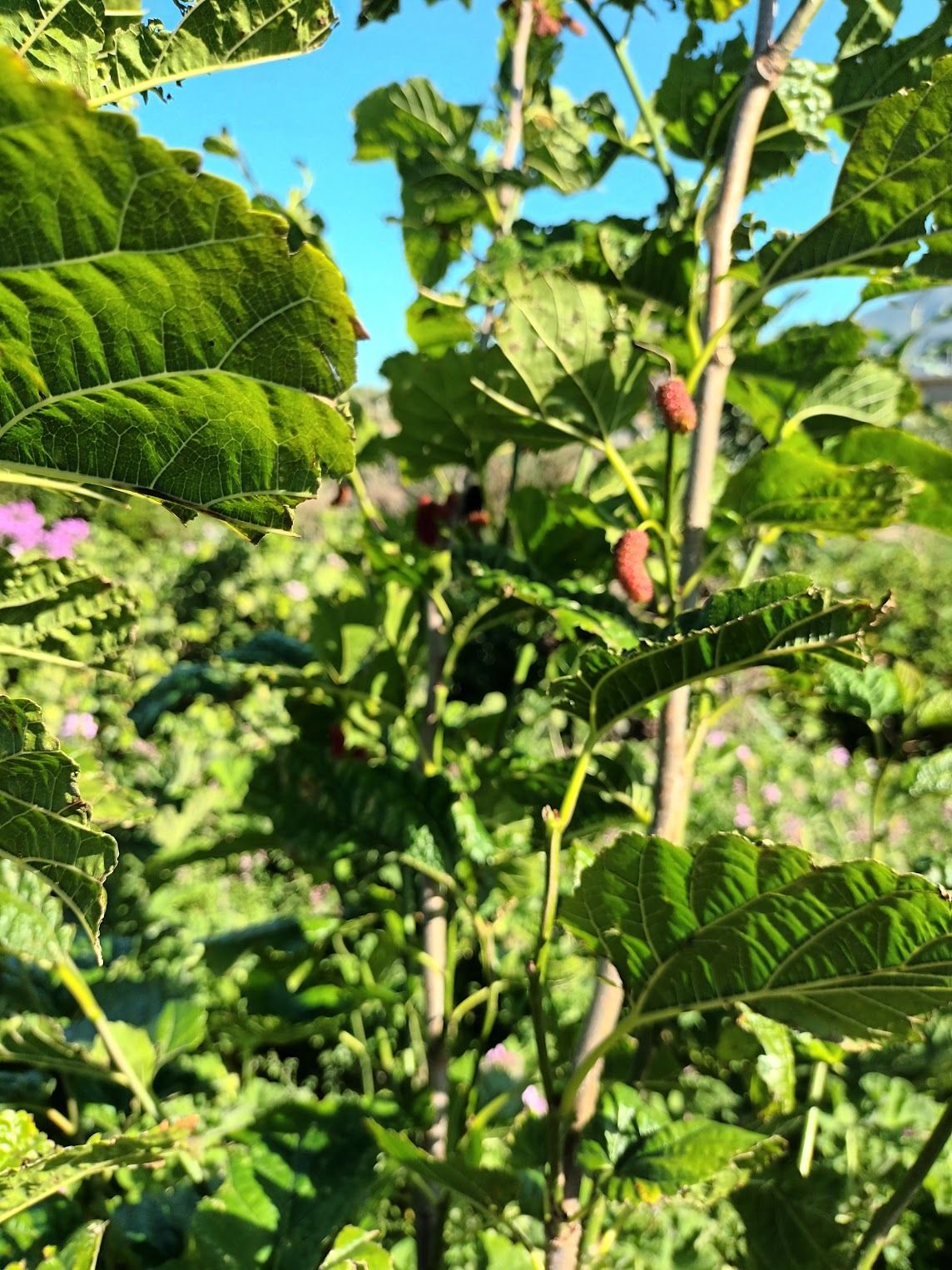
Dragonfruit
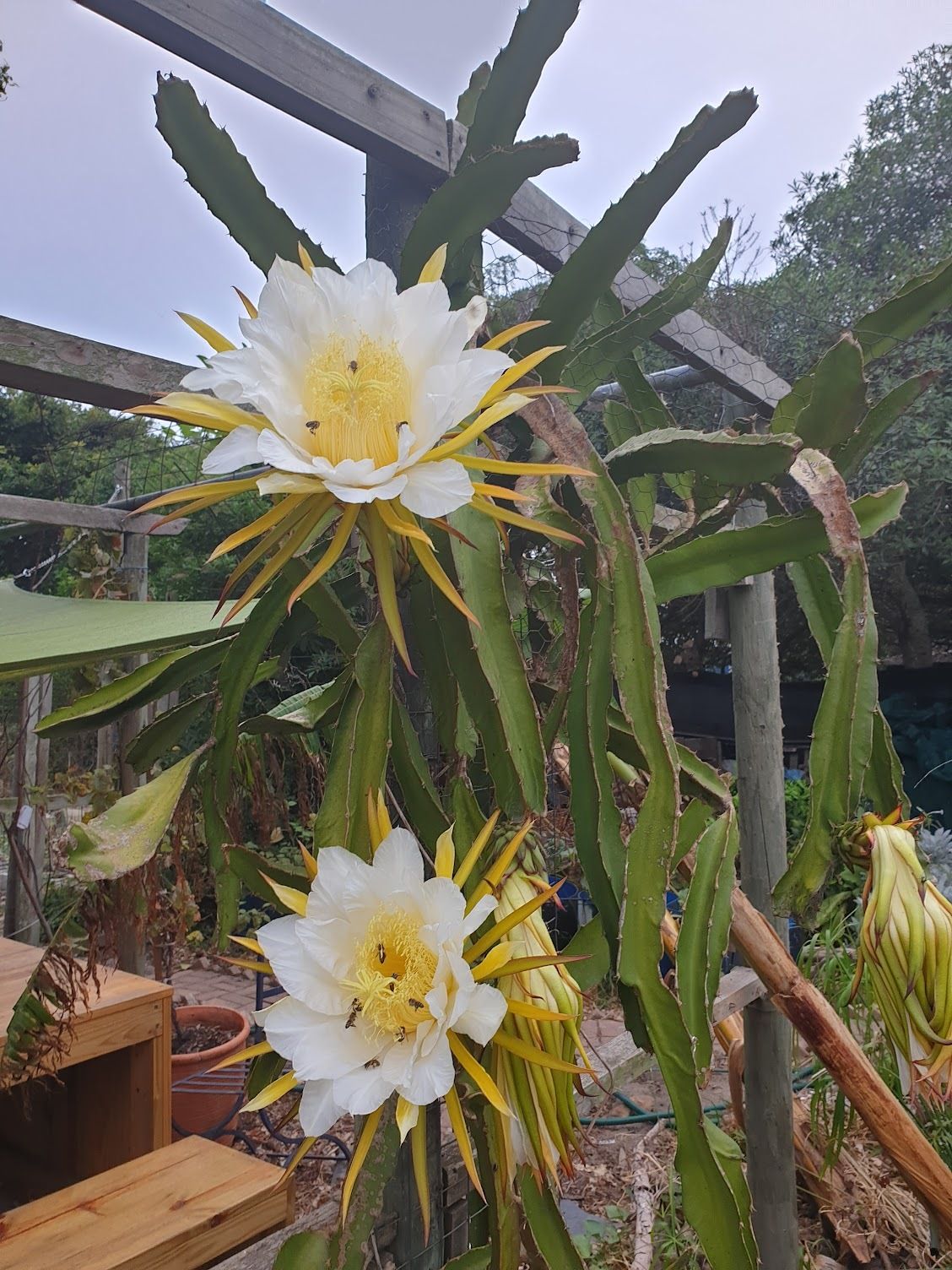
So many bees
Dragonfruit has to be hand pollinated, because it’s from SE Asia where it’s pollinated by bats. So you channel your inner bat, get your hand in there and pollinate. AND, to make it more exciting, you have to do in in a relatively short (3-6 hr) window when flowers are open and not wilting. Other than than that, Dragonfruit are easy to grow, readily available, and don’t require as much water as most fruit trees.
In the leafy/softer suburbs they are a bit invasive (not the far south, but perhaps in Noordhoek they would be). They are very easy to propagate from cutting, and affordable to buy. For us, they give a relatively small number of fruit each year, but they’re also very little trouble to keep, and the flowers are glorious.
Macadamia Nuts
Yes, you can grow macadamias, and they grow really well! They don’t need massive amounts of water, but they grow slowly. I’m really grateful for my kids and dad’s patience cracking the nuts… The spiky leaves and tolerance of wind means they can work well as a perimeter tree.
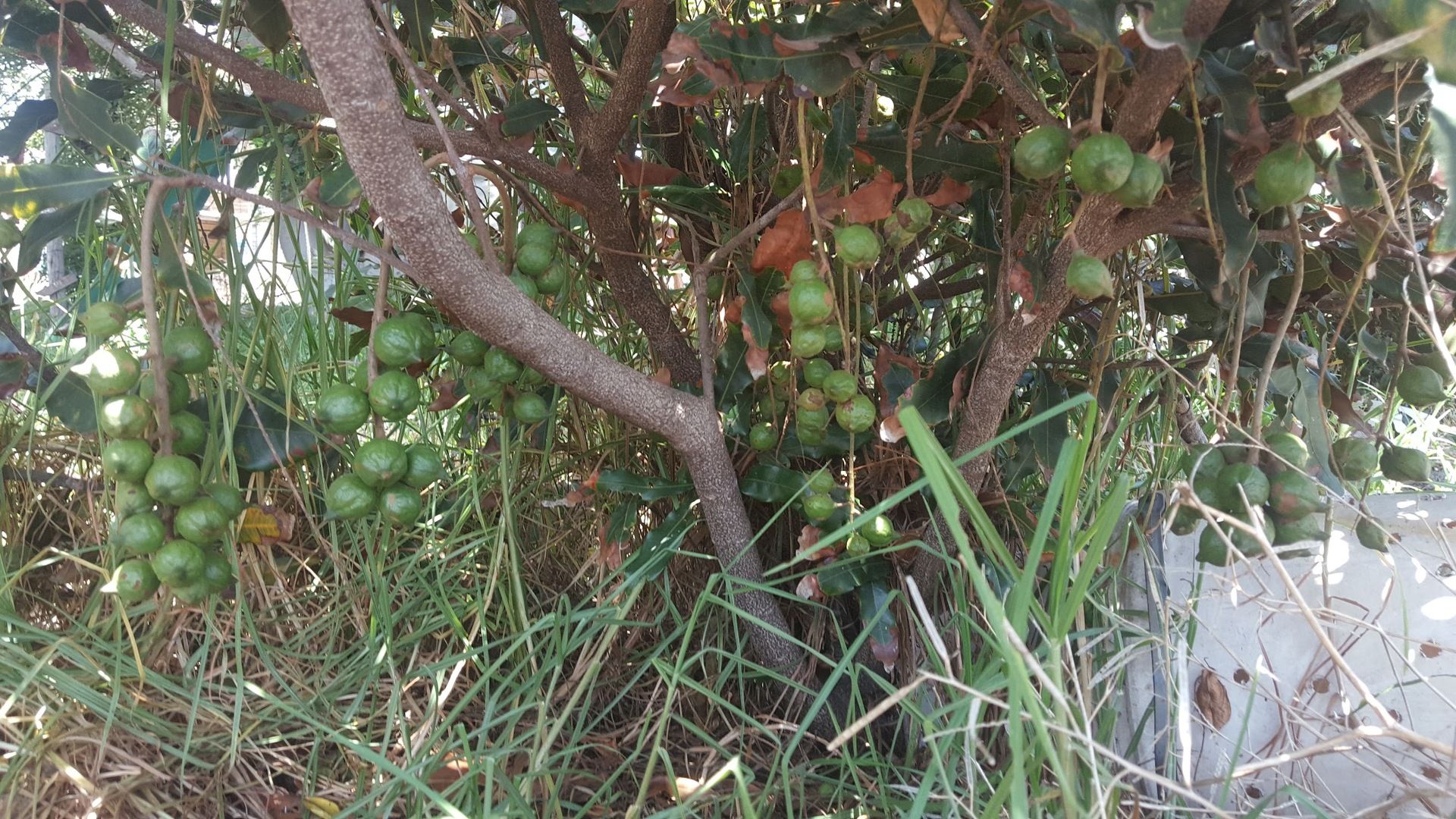
Almonds, Peaches, Plums, Nectaries and Apricots
For all stone fruit, experimentation is good- finding the varieties you enjoy and that do well in your space. You should not give up if a tree doesn’t thrive.
We focus almost exclusively on early ripening varieties, to get a higher proportion of fruits that are not stung. Apricots (soldonne) and Plums (flavour King) are prolific and delicious, and you choose varieties that ripen early enough that you get mostly unblemished fruit. Almonds are not as prolific, but they’re beautiful and hardier than the other stone fruit. You can eat green almonds! And you don’t have to worry as much about almonds getting stung, because you’re eating the almond not the mature flesh.
Nectarines often try to bear fruit before they are ready, which kills the tree. Alphen nectarines ripen early and don’t get stung. Similarly, any early ripening peach is a good choice, but we tend to have more peaches that are stung, perhaps because the skin stays softer and the fruit gets larger than apricots or plums.
You can learn to prune stone fruit, and this helps a lot with yield. Stone fruit are AMAZING when they are doing well, but they are more demanding in the beginning: they require a bit more protection from wind, especially when they’re flowering. But now that we have plenty of trees fruiting, we have extraordinary abundance in a small space.
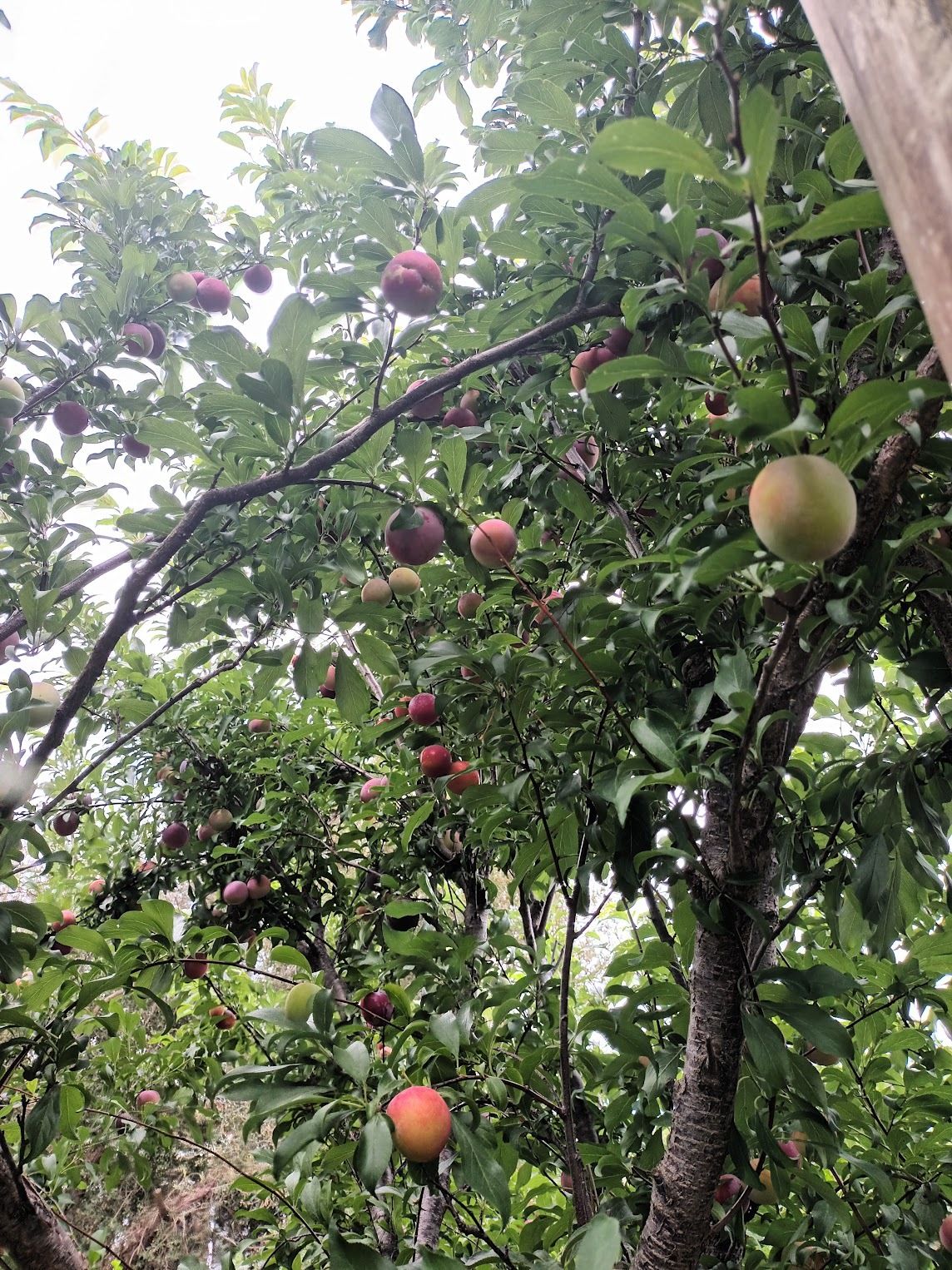
Citrus
All citrus grows well in Cape Town, yet I have also found them more difficult than some other trees, because most citrus doesn’t like wind. Lemons can cope with the most wind, particularly Cape Roughskin lemons. We grow limes (second easiest after lemons), Oranges, Naartjies, Pomelos, kumquats, grapefruit.
With the exceptions of lemons, citrus grown in the most sheltered — even extremely shaded— parts of our garden have fared the best, and planting 20L trees (rather than a smaller size) has led to better outcomes and better trees. If you’re in the leafy suburbs, you may find that growing citrus is easy! Citrus love the shelter and large tree cover of parts of the southern suburbs. They need consistent water, consistent compost, and will often regress significantly when planted if you don’t have time to give them water and compost.
You CAN grow citrus, just focus on growing in sheltered spots- perhaps close to the house- where you can keep the soil moist but not waterlogged. Citrus has a large proportion of roots at the surface, which means it can dry out quickly and also become waterlogged quickly. It doesn’t like to have mulch or compost right up to the trunk, as the trunk is susceptible to insect damage.
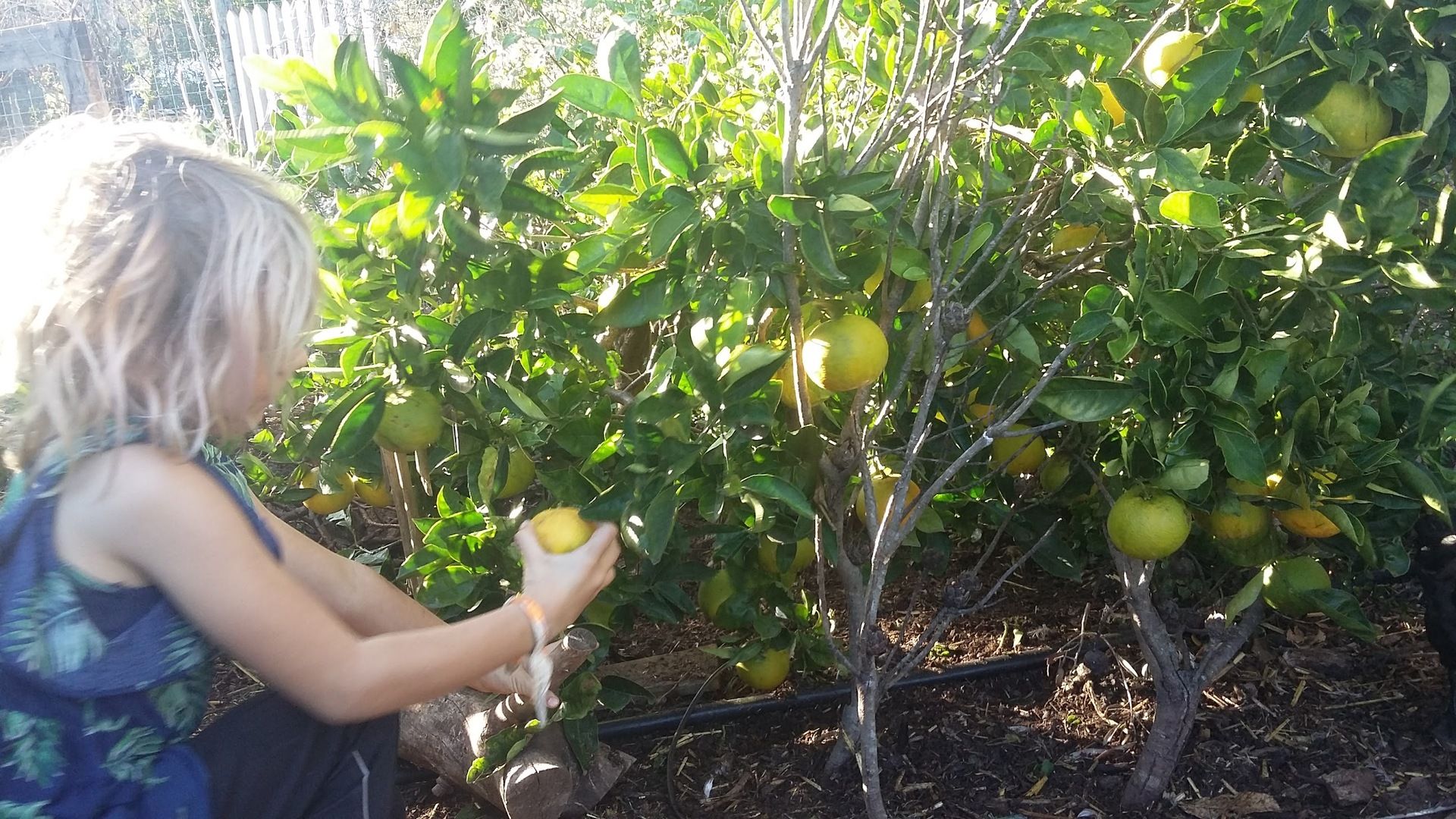
Pomegranate
We have many pomegranate trees, but we have only recently persuaded them to fruit. They are slow relative to some of our other trees. The three things that helped: pruning in winter, so they only had limited branches. Watering well. Patience.
Pomegranates can manage drought AND wind, which is wonderful. However, to fruit they like regular watering. So the good news is if you forget them they won’t die, but they may not fruit either. As they grow, they become more independent and don’t need intervention. They are beautiful trees, and the branches are spikey so they work well as a perimeter tree/security hedge. We have around 40 growing along our fence line as a fruiting hedge.
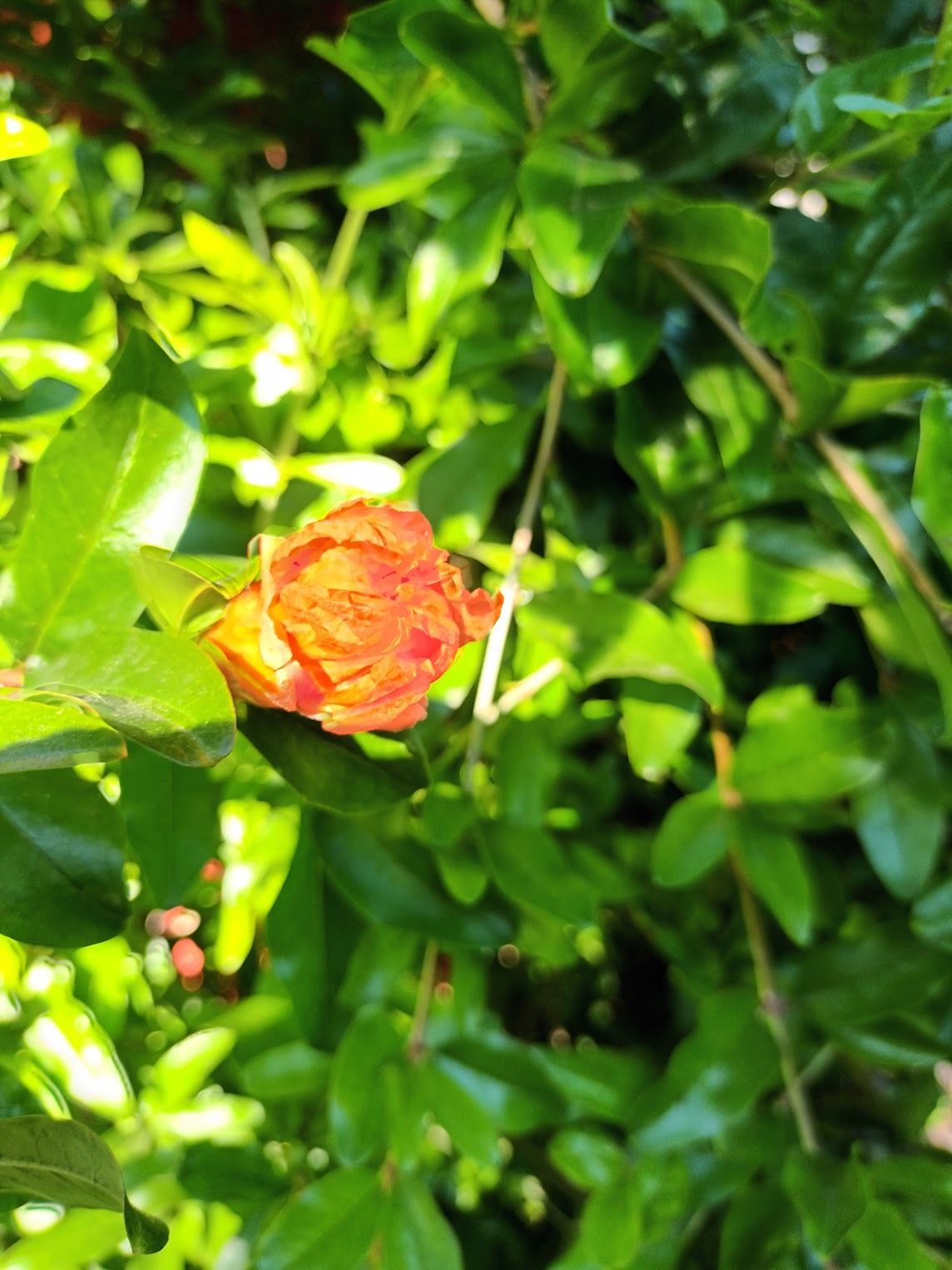
Custard Apple and Feijoas
I know both custard apples and feijoas can grow here, but ours are still a little small, so I can’t offer advice yet.
Apples & Pears
Apples and pears both grow and bear well. But they’ve been slower than stone fruit in bearing substantial volumes. Stone fruit, guavas, dragonfruit, all berries are immediately vastly better than store-bought, because they can be harvested very ripe and it’s so rare to find organic versions. Organic apples and pears are also very difficult to find, but so far the taste and size of our fruit is not consistent. This year, we have a lot of Anna Apples ripening, so I hope to update this soon with a note on our success.
For both apples and pears, you need to check for low-chill requirements, as some (granny smith, early red) require too many chill hours to fruit in Cape Town. We have had the most success with Anna apples and Forelle & Packam pears. Since they’re slow, there’s a case for getting 50L trees (yes you can fit a 50L tree into most cars).
There’s also a case for getting more than one tree, because you don’t always know how a tree will adapt to transplant. Like many fruit trees, we’ve grown many apples and pears over the years and it hasn’t always been intuitive which has survived and who has died- sometimes small differences in local soil conditions seemed to determine success. They can take more wind than most citrus, but they will also be happy to not have to struggle against the wind.
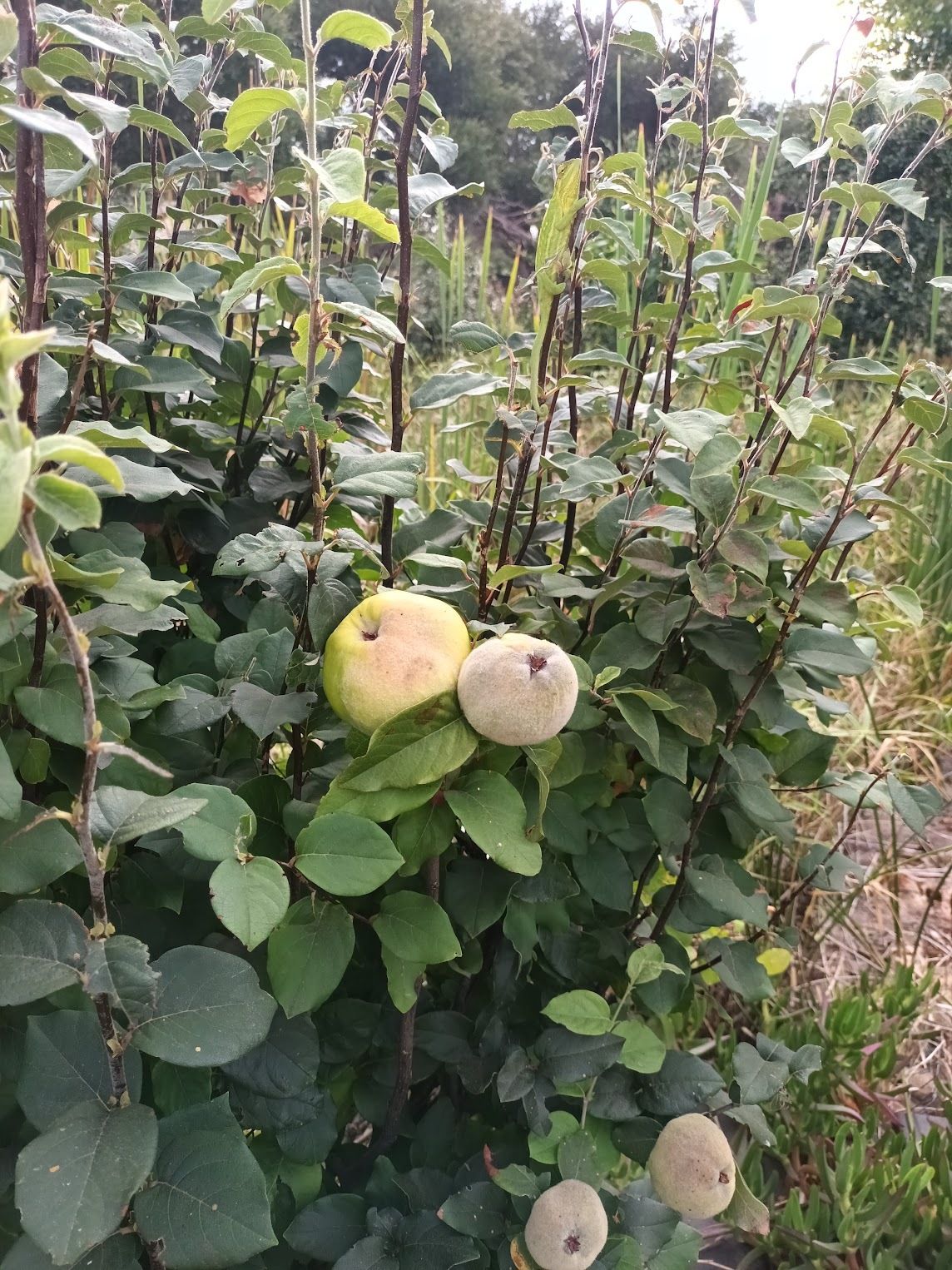
spot the chameleon…
Quince
Quince are an easy and beautiful tree to grow: they can handle wind and fruit prolifically. I sometimes struggle to process the quince quickly enough, because they need to be cooked for a long time, and I hope this year will be the year of quick processing! Our quince tree is a base for our chameleon population- five chameleons share the tree (each with their own territory), and they give birth and the babies move across our property in record numbers.
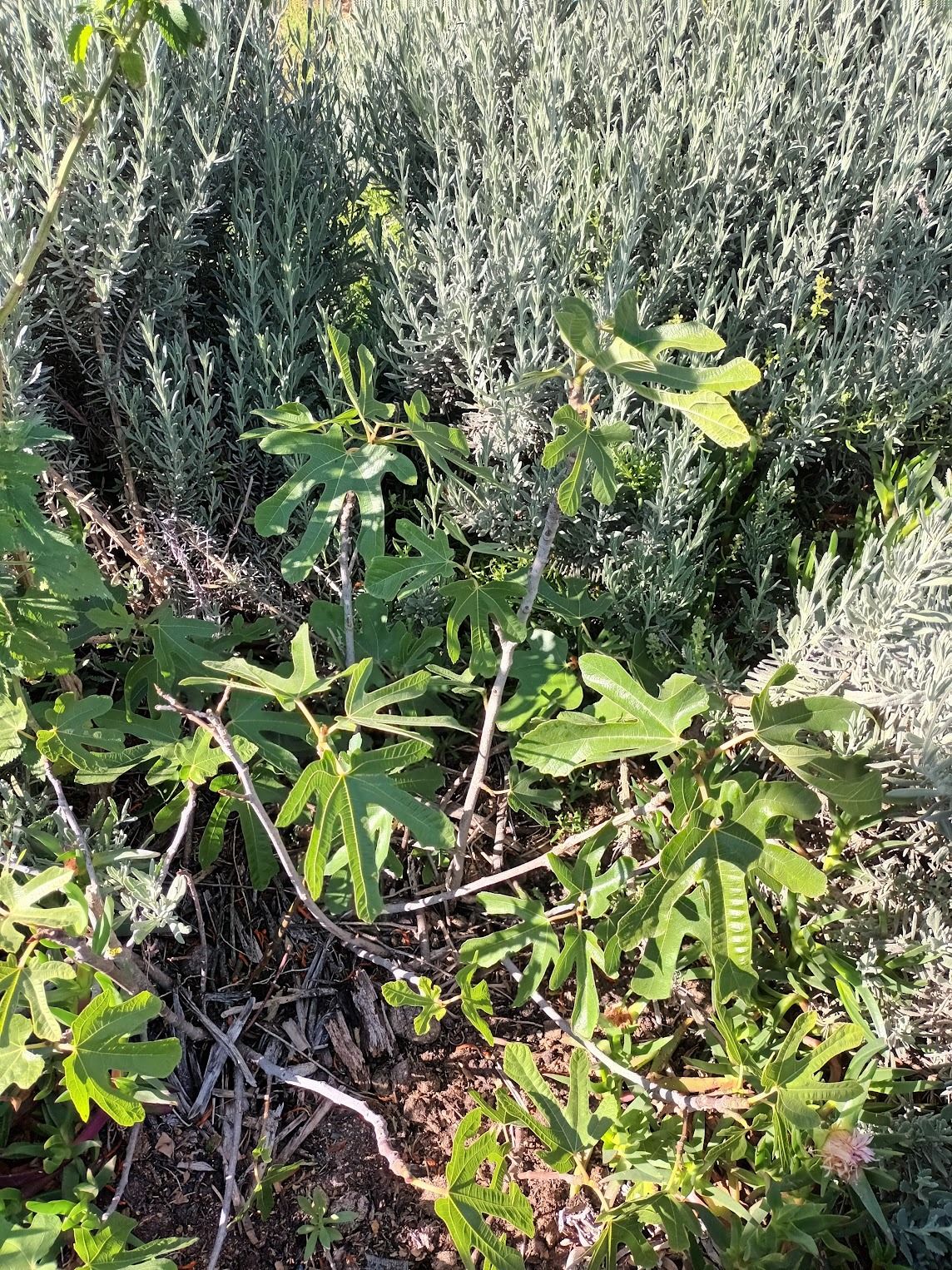
Figs
Easy to grow, easy to propagate. They can handle wind and drought conditions.
They have an invasive root system so it’s best not to plant them close to infrastructure. The tastiest figs (striped/toulouse) are a much smaller, slower growing tree. They tend to succumb every few years to beetles, so it’s a good idea to propagate new trees from cuttings in the winter. We lose a lot of figs to birds, so this year we will cover our figs with bird netting.
Grapes
Most of the grapes that you see in shops are not grown organically, and it can be a challenge to avoid fungal infections and birds. Pruning grapes for airflow helps avoid fungal infections, and growing small varieties allows us to get proportionally more grapes.
Flame seedless and Crimson seedless are two of my favourite varieties, because they ripen quickly and I’m able to actually eat nice-tasting grapes. My dad’s favourite variety is hanepoort, but I find they need to be picked unripe and this means they don’t taste as good.
Mangos
Mangos do grow in Cape Town, but you need to find the warmest and most protected part of your garden. For example you can grow against Jojo/watertanks, near to a warm wall. They grow really well near septic tanks, as they’re heavy feeders and drinkers. Our tree started to bear but was killed by mole rats, so we’re starting over.
Avocados
I have not had success with Avocados in our harsh windy sandy environment, but I know there are people growing avocados in Observatory, Noordhoek, across the southern suburbs, and in the Northern suburbs. They are expensive to buy and tend to be very small at purchase, which I think is the main problem preventing them from growing in environments like ours. They have very long tap roots that can be broken when transplanted. I’ve sold quite a few avos over the years, and when I followed up with people, I have yet to find someone who was successful. So I’ve largely stopped selling them.
Given these realities, I would recommend growing from seed directly into the ground where you’d like them to be established, or in a pot, despite the very lengthy wait time involved and the uncertainty over the quality of the resultant fruit. When I’ve investigated prolific trees across the city, they tend to be well-established, and grown from seed by a patient member of a previous generation. So I’d like to be that patient person, this generation.
Bananas
You can grow bananas, and you can grow large, tasty, bunches! It takes patience, lots of water, and tons of nutrients.
This means they should be placed by blackwater/greywater systems, near compost heaps, and near outside taps, near the overflow from rain gutter tanks, near to septic tanks. They can manage waterlogged conditions, as long as they can grow quickly in summer and have plenty of nutrients. If possible, protect from wind. They can manage very shady conditions, so they can be a good understory tree IF you have compost or moisture sorted out.
They are beautiful and our bananas add so much to the enjoyment of our property. Like many subtropical/tropical trees, starting and then just continuing to improve the soil, will mean eventually you will have plenty of trees for your needs, and maybe even enough bananas for the year!
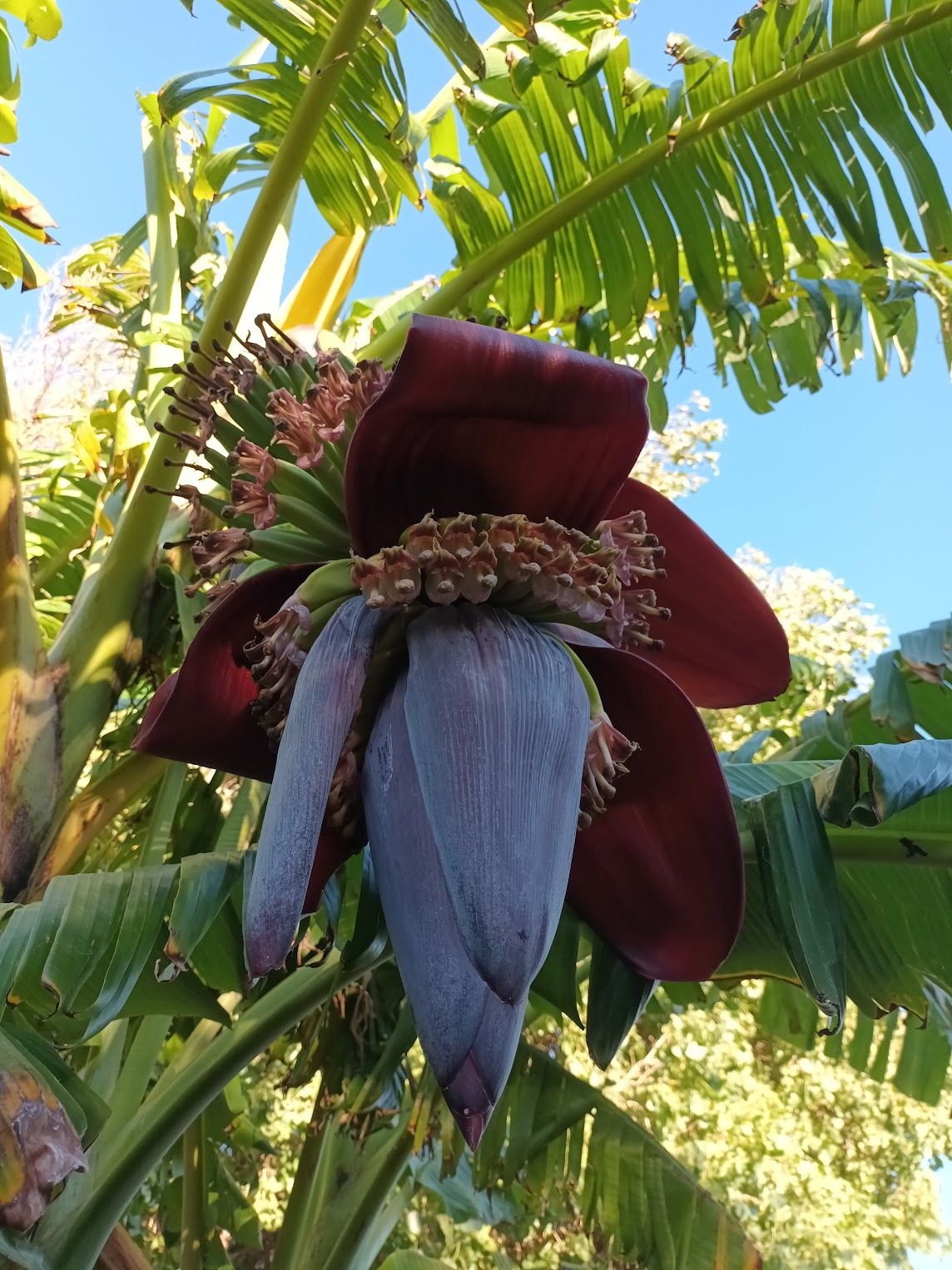
Whew. That was long. Feel free to ask me fruit and nut questions, and I’ll keep adding to this post!
Workshops
If you have a company group or a group of family or friends that you’d like to learn composting, growing, chicken rearing, sourdough baking, cheesemaking or some other topic, let me know. It could be a fun way to connect with colleagues, friends and family. |
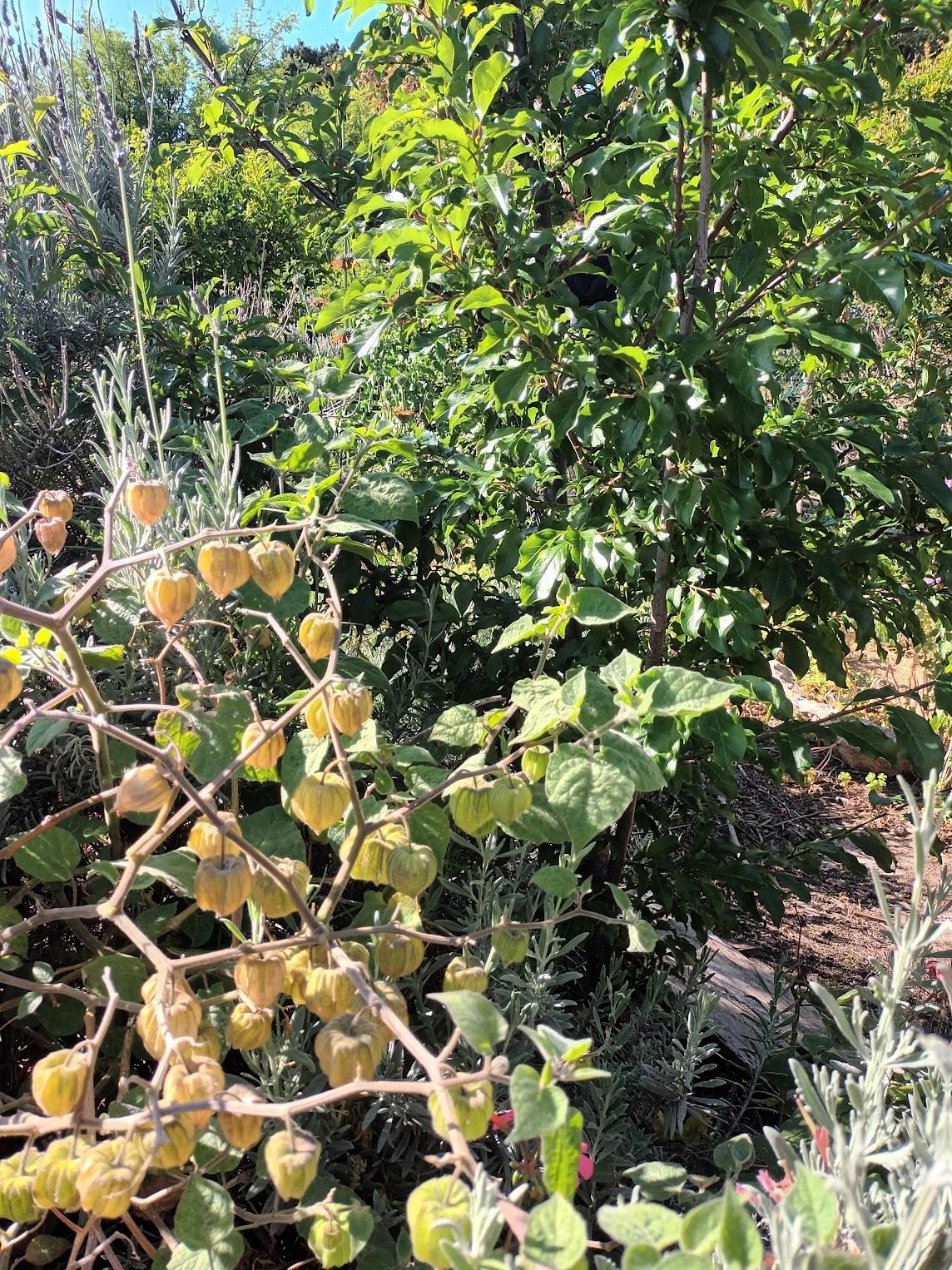
Here’s to food forests and abundance.
If you are enjoying our newsletter, consider forwarding on to someone in your community. If you received this from a friend, you can sign up here

Reply